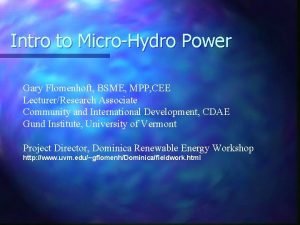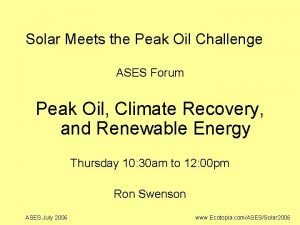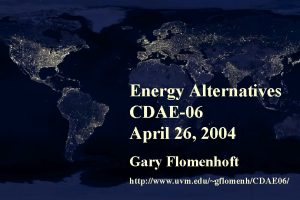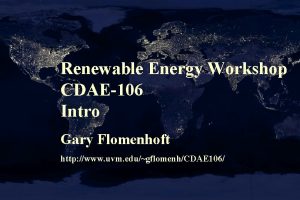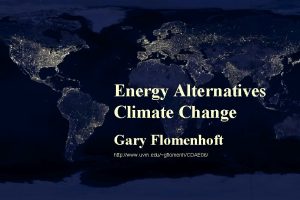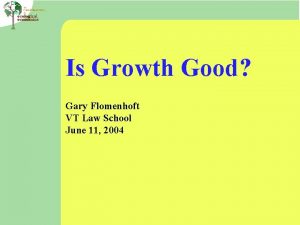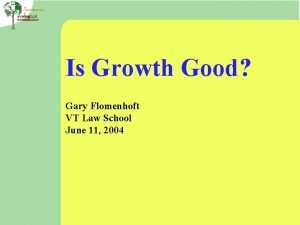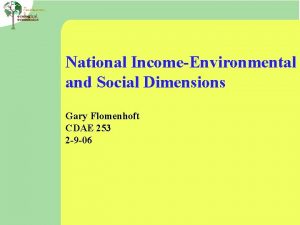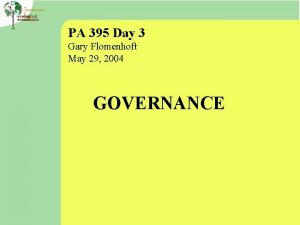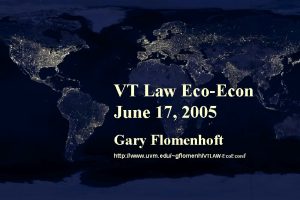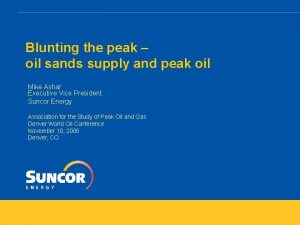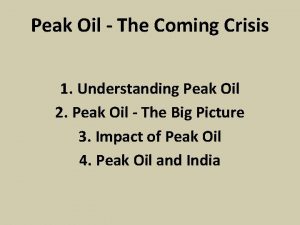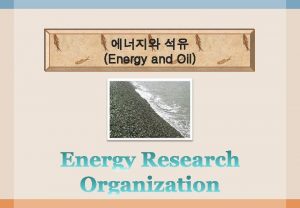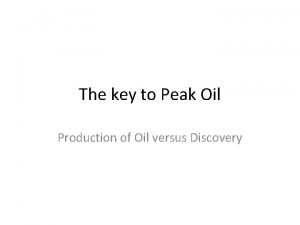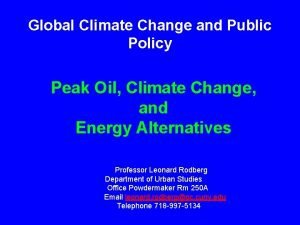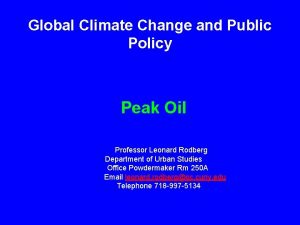Energy Policy Oil Peak Gary Flomenhoft The OIL














































- Slides: 46

Energy Policy Oil Peak Gary Flomenhoft

The “OIL PEAK”

Source: Smil (1991)

Composition of U. S. Energy Use Percent of total energy use 100 75 coal wood oil 50 gas 25 animal feed electricity 0 1800 1825 1850 1875 1900 1925 1950 1975 2000


Energy Rate of Return


Work Done in the U. S. Economy, 1850 -1970 Labor Domesticated Animals Fuel

The Epoch of Fossil Fuel Exploitation (after Hubbert, 1969) Trillion kwh per year 300 200 100 -5 Stonehenge Built -4 -3 -1 -2 0 Mayan culture Steam Parthenon Engine completed Pyramids Iron in constructed Black Middle Death East Inquisition Magellan's Circumnavigation +1 +2 +3 +4 +5

Hubbert Oil Cycle

US Oil Extraction

US Oil Extraction

World Oil Extraction

Results- Various Countries Algeria (EUR=26. 09 BBO) Mexico (EUR=65. 0 BBO) Norway (EUR=35. 2 BBO) Romania (EUR=7. 3 BBO)

World Oil Extraction

World Oil Extraction

World Oil Extraction

World Oil Extraction


Various National Patterns USA – E. g. . of a net consumer Venezuela – E. g. of a net producer High reserves (~ 3000 BBO) and low economic growth scenario

Various National Patterns Mexico– E. g. . of a country that switches over from net producer to net consumer in the future. U. A. E. – E. g. of a swing producer. High reserves (~ 3000 BBO) and low economic growth scenario

Forecasting Oil Production U = ~ 3000 (mean estimate of the USGS 2000). Peak Production = 2037 Source : US DOE (EIA), website.

World Oil Extraction

World Oil Extraction

World Oil Consumption

World Oil Flows

Two Views • Julian Simon view: technological developments and human ingenuity will yield more resources –“Drowning in oil” The Economist, March 6 th 12 th 1999, pp. 23 -25 • Colin Campbell, et al. use Hubbert curves to predict the end of oil S. Gürcan Gülen, Ph. D. –“The End of Cheap Oil” Scientific American, March 1998, pp. 78 -83 (Campbell and Laherrere)

Real Price of Oil since 1869

Real Price of Oil since 1869

Oil Reserve/Production ratio

Oil Reserves

“Proven” oil reserves

Natural Gas Reserves

Natural Gas Reserves

Coal Reserves


Gas Hog Tax Credit Hummer H 1 Sticker price $106, 185 Current law Equipment deduction $25, 000 Total tax deduction* $60, 722 Bush economic plan Equipment deduction $75, 000 Total tax deduction* $88, 722 * Includes bonus tax write-off enacted by Congress in March 2002 and a deduction for normal depreciation. Sources: Detroit News research, IRS, Taxpayers for Common Sense

Cars per Thousand People Source: Just. Auto. com Thomas Gross, US DOE “Today there are 670 million vehicles in the world. By 2050 that number is expected to increase to 4. 5 billion or maybe more. ”


China Energy use 1997


Source: EPA

American success Great natural resources Energy subsidies: slaves then fossil fuels Global trade



Other Extinct cultures Rapa Nui- (Easter Island) Mangaia Mangereva Pitcairn Henderson Exception: Tikopia
 Gary flomenhoft
Gary flomenhoft Convert from rms to peak
Convert from rms to peak Peak to peak voltage
Peak to peak voltage Widows peak dominant
Widows peak dominant Peak oil forum
Peak oil forum Oral emulsion example
Oral emulsion example Energy energy transfer and general energy analysis
Energy energy transfer and general energy analysis Energy energy transfer and general energy analysis
Energy energy transfer and general energy analysis Hát kết hợp bộ gõ cơ thể
Hát kết hợp bộ gõ cơ thể Lp html
Lp html Bổ thể
Bổ thể Tỉ lệ cơ thể trẻ em
Tỉ lệ cơ thể trẻ em Gấu đi như thế nào
Gấu đi như thế nào Tư thế worms-breton
Tư thế worms-breton Chúa sống lại
Chúa sống lại Các môn thể thao bắt đầu bằng tiếng nhảy
Các môn thể thao bắt đầu bằng tiếng nhảy Thế nào là hệ số cao nhất
Thế nào là hệ số cao nhất Các châu lục và đại dương trên thế giới
Các châu lục và đại dương trên thế giới Công thức tiính động năng
Công thức tiính động năng Trời xanh đây là của chúng ta thể thơ
Trời xanh đây là của chúng ta thể thơ Mật thư tọa độ 5x5
Mật thư tọa độ 5x5 Làm thế nào để 102-1=99
Làm thế nào để 102-1=99 Phản ứng thế ankan
Phản ứng thế ankan Các châu lục và đại dương trên thế giới
Các châu lục và đại dương trên thế giới Thơ thất ngôn tứ tuyệt đường luật
Thơ thất ngôn tứ tuyệt đường luật Quá trình desamine hóa có thể tạo ra
Quá trình desamine hóa có thể tạo ra Một số thể thơ truyền thống
Một số thể thơ truyền thống Bàn tay mà dây bẩn
Bàn tay mà dây bẩn Vẽ hình chiếu vuông góc của vật thể sau
Vẽ hình chiếu vuông góc của vật thể sau Thế nào là sự mỏi cơ
Thế nào là sự mỏi cơ đặc điểm cơ thể của người tối cổ
đặc điểm cơ thể của người tối cổ V cc cc
V cc cc Vẽ hình chiếu đứng bằng cạnh của vật thể
Vẽ hình chiếu đứng bằng cạnh của vật thể Fecboak
Fecboak Thẻ vin
Thẻ vin đại từ thay thế
đại từ thay thế điện thế nghỉ
điện thế nghỉ Tư thế ngồi viết
Tư thế ngồi viết Diễn thế sinh thái là
Diễn thế sinh thái là Dạng đột biến một nhiễm là
Dạng đột biến một nhiễm là So nguyen to
So nguyen to Tư thế ngồi viết
Tư thế ngồi viết Lời thề hippocrates
Lời thề hippocrates Thiếu nhi thế giới liên hoan
Thiếu nhi thế giới liên hoan ưu thế lai là gì
ưu thế lai là gì Hươu thường đẻ mỗi lứa mấy con
Hươu thường đẻ mỗi lứa mấy con Khi nào hổ mẹ dạy hổ con săn mồi
Khi nào hổ mẹ dạy hổ con săn mồi
